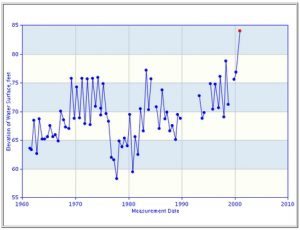 I’m always amazed at how many small water systems, not to mention domestic well owners, do not keep track of water levels in their wells. Measuring water levels is simple to do, but can tell you a lot about the performance and health of your well over time.
I’m always amazed at how many small water systems, not to mention domestic well owners, do not keep track of water levels in their wells. Measuring water levels is simple to do, but can tell you a lot about the performance and health of your well over time.
There are really two water level measurements that should be made in the well on a regular basis: 1.) a static water level made during non-pumping conditions; and, 2.) a pumping water level made while the pump is operating under normal conditions.
The difference between the static and pumping water level measurements is the drawdown in the well which can change over time if the well begins to plug up. An increase in the depth to water under pumping conditions with little to no change in the static water level means is generally indicative of some sort of plugging in the well. Lowering of the static water level over time is often indicative of drought conditions or overpumping the aquifer.
Water levels can be measured in a variety of ways. Most common is the use of a reel-mounted electric tape with a water sensitive probe that is lowered into the well and triggers an alarm when it contacts water. These electric tapes are accurate to within 1/100 of a foot. Another method for monitoring water levels in wells is through the use of a sonic water level meters, which can be used both as a temporary well level measurement tool or permanently installed in a well to automatically record water levels over time. Sonic meters are often accurate to within 1/10of a foot, but have a high convenience factor. The last method for monitoring water levels in a well is through the use of a pressure transducer/datalogger. This set up uses a pressure transducer to record the height of the water column over the top of the transducer. The data is then stored in the datalogger for direct read or periodic downloading and processing. The pressure transducer can generally register water levels to within 1/100 of a foot when properly calibrated and corrected for barometric pressure.
To track water levels over time, the data for both static and pumping water levels should be charted over time to observe trends and to identify potential plugging issues before they endanger well production.

